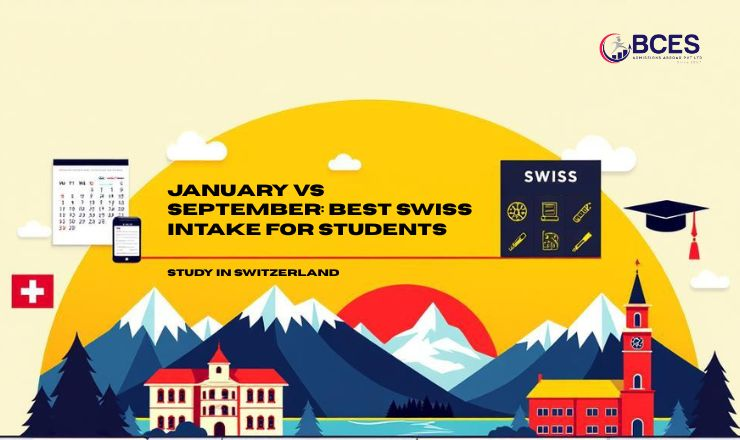January or September: Which Intake is better for International Students to study in Switzerland

31 July 2025
Switzerland is a paradise for the majority of foreign students, particularly those who aspire to academic greatness, international exposure, and a superlative lifestyle. But prior to starting your preparations, there’s one major decision you must make: Which intake is preferable – January or September? This seemingly harmless question can make all the difference in your experience, from admission chances to post-study opportunities.
Switzerland has two main intakes – January (Spring) and September (Fall). Although both have their own merits, your desired intake relies on your study history, career schedule, visa processing period, and course timetable. This article will help you to understand the main differences and choose which one is best suited for your needs.
With Switzerland gaining popularity for business, hospitality, and STEM programs, students must navigate through emerging admission timelines, processing timelines, and various institutional preferences.
Every intake has its own set of distinguishing factors. Let’s dive into them.
Switzerland January Intake
Switzerland January intake, or January/Spring intake, is the second most significant admission cycle. Start dates vary from university to university and course to course, with the earliest starting in January and the latest in February.
Advantages of January Intake
Reduced Enrollment Competition: The January Intake is less popular than the September Intake so fewer people will be competing for the same position in some courses.
Opportunity to Retake: January allows for recapturing missed September opportunities to improve the profile, prepare documents, and apply for the available scholarships.
Possibility of Intern: Early starts can allow for better alignment with summer internship and work placement schedules.
Factors to Consider
- At the bachelor’s level, there are some universities and courses which will not accept students for January Intake.
- Limited student accommodation in some cities can be an issue, and there are some with missed scholarship opportunities.
September Intake in Switzerland
Almost all universities and colleges in Switzerland have a September or Fall Intake. Most courses start between the middle of August and the beginning of October.
What drives students toward September Intake
Larger Selection of Programs: From bachelor’s to master’s level, nearly all courses are available for September Intake.
Orderly System: The school and university system of the world functions similarly, which allows for ease of transitioning for international students.
Increased Scholarships and Campus Activities: To mark this intake, many colleges and universities award scholarships, host welcome functions, and run orientation programs. In addition, this timing complements networking and job fairs in Switzerland.
Essential Information
- Higher competition translates to a “first come, first serve’ visa policy and requires a well-prepared document checklist.
- During peak months like June and July, visa appointment slots might get congested, particularly during high-demand periods like June and July.
Your preferred intake should be assessed based on academic readiness, preferred program, visa timelines, and financial standing. If you want a dynamic campus with a plethora of options and scholarships, the September intake is ideal. If you want a flexible, low competition, and faster admission process, then the January intake is better suited.
Both options provide high-quality education, global exposure, and ample opportunity for career advancement. It’s all about timing and strategy.
Whichever intake you prefer, BCES Admissions Abroad is with you every step of the way. From identifying the most suited universities and courses to visa applications and scholarship submissions, we ensure a hassle-free and rigorous preparation for your study abroad experience. Reach out to us at +91 8800096600 and let our experts guide you on the first step towards studying in Switzerland.
Frequently Asked Questions (FAQs)
It works for international students who missed September intake or want additional preparation time. However, there might be fewer courses available.
Some universities do, but there are fewer opportunities compared to September. Make sure to confirm with your preferred university early.
Certainly, international students in Switzerland are allowed to work part time during both intakes with a maximum of 15 hours a week.
They should begin outreach 8 to 10 months in advance. For January intake, reach out in March or April, and for September, in October or November of the prior year.
Job opportunities for both intakes remain unchanged for post-study work. September intake students might have access to more career fairs and on-campus hiring events.